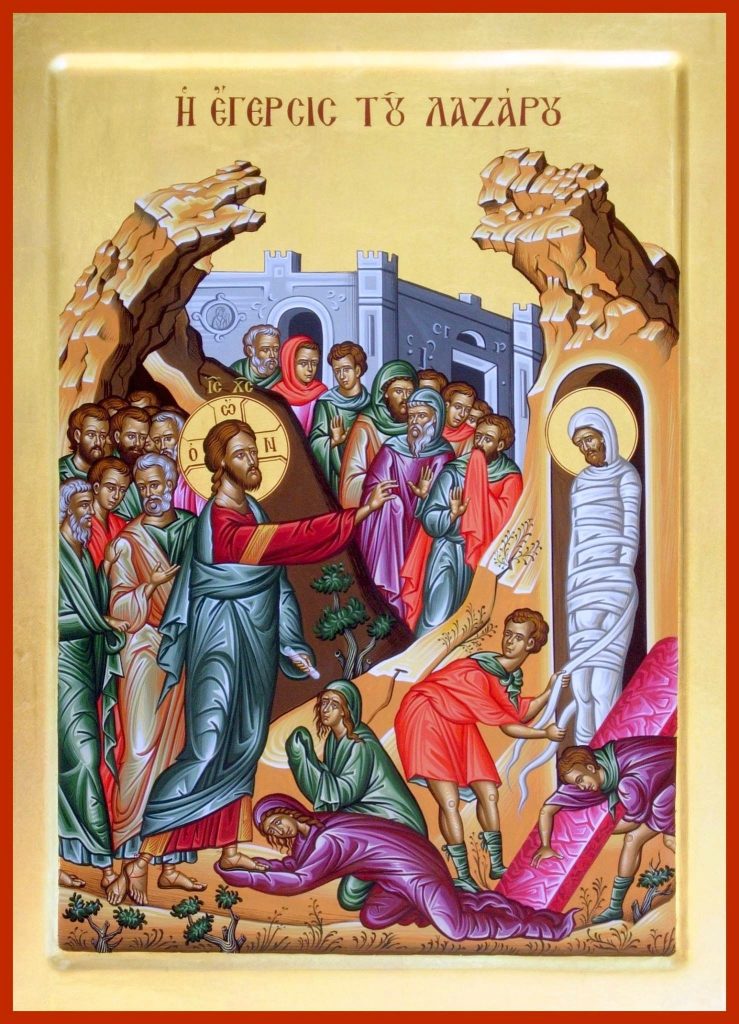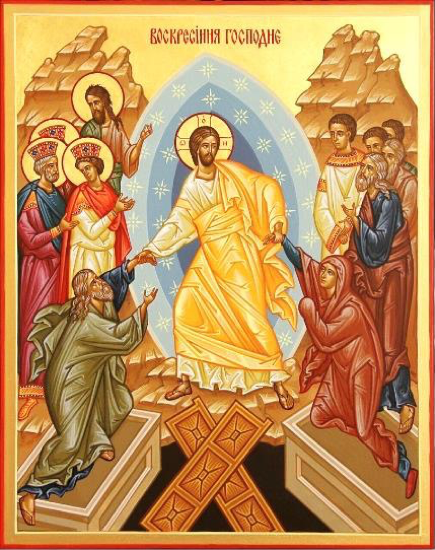
Saturday 4 April 2020
Lazarus Saturday
The Great Fast (40 days) ends on Friday, 3 April. Lazarus Saturday and Palm Sunday form a short and joyous prelude to the days of grief which will follow. Bethany is the place where Jesus raises Lazarus from the dead and reveals Himself to be ‘the Resurrection and the Life.’ ‘Those who believe in Me, even though they die, will live’ (John 11:25). Bethany is also the point of departure for Jesus’s entry into Jerusalem. On this Saturday, we go to Bethany, to Lazarus’ tomb. We want to meet Jesus at Bethany and to start Holy Week with Him, close to Him. Jesus invites us to be there, and He waits for us.
Sunday 5 April 2020
Palm Sunday
The public ministry of Jesus ends with two great events: the raising of Lazarus from the dead, and the triumphant entry of Jesus into Jerusalem. These two events, witnessed by many people, give testimony to the fact that Jesus is not only the promised Messiah, but He is also the Lord, the Son of the living God. Just as the people greeted Christ with branches from the trees, so Christians also greet Christ with ‘palms of virtue’ as He enters upon His voluntary passion.
Monday 6 April 2020
Holy Monday
In the morning, Jesus returns to the city of Jerusalem. On the way, He finds a fig tree with no fruit. He curses it and immediately it withers away. After three years of teaching and healing, the leaders and the people of Israel have not accepted His message. Like the fig tree, they have remained barren, without fruit. With this prophetic and symbolic act, Jesus warns those in every generation of what will befall anyone who fails to listen to His message. Arriving in Jerusalem, Jesus enters the temple, where the chief priests and elders question His authority.
Tuesday 7 April 2020
Holy Tuesday
As the chosen Lamb of God, Jesus is without blemish. He is tested and questioned by the Pharisees and the Sadducees, who hope to trap Him in some way, but they cannot find any fault in Him. Jesus’ answers are astonishing. In the end, Jesus pronounces judgment upon the scribes, the Pharisees and leaders of Israel, who had the God-given authority to teach God’s Law, but were personally ungodly and cold of heart.
Wednesday 8 April 2020
Holy Wednesday
In the morning at Matins, during the reading of the Gospel, Jesus announces: ‘The hour has come that the Son of Man should be glorified.... For this purpose, I came to this hour. Father: glorify Your name’ (John 12:23-28). As Jesus says this, the voice of the Father from heaven is heard, saying: ‘I have both glorified it and will glorify it again’ (John 12:28). Judgement is upon the world, and Satan’s dominion over the world is about to be conquered. When Jesus is lifted up (His Crucifixion, Resurrection, Ascension), ‘He will draw all peoples to Himself’ (John 12:31). In the evening, the Gospel reading at the Presanctified Liturgy presents to us the contrast of two figures, two states of the soul. We remember the action of the woman, who at Bethany came to pour a jar of precious ointment on Jesus’ head; and the action of the disciple, Judas, who betrayed his Master. It was Judas who protested in response to the woman's action. Jesus approved of the woman's action, because it was an act of genuine love and worship, expressed in anticipation of His death and burial. The Sacrament of Holy Anointing is administered to all who desire to receive spiritual and physical relief.
Thursday 9 April 2020
Holy Thursday
Holy Thursday takes us into the Mystery of the Passover. It commemorates and makes present to us the first part of this mystery, the part that takes place in the Upper Room. The Lord Jesus, really present both as He who distributes and as He who is distributed, gives Himself to us in the Eucharist. All faithful Catholic and Orthodox Christians believe that in Holy Communion, they receive the most holy and precious Body and Blood of Jesus Christ, their Lord and Saviour. On Holy Thursday, after the Mystical Supper in the Upper Room, we follow Jesus to the Garden of Olives: his priestly prayer, arrest, and passion.
Friday 10 April 10 2020
Holy Friday
On Holy Friday, we remain with Jesus in the moments of His passion, His trial before Pilate, His scourging, His sentencing, the carrying of the cross, His crucifixion, death, and burial. During the Vespers Service, we join Joseph of Arimathea and Nicodemus, to take down Jesus’ body from cross, to bind it in linen cloths with spices, to carry it in procession, and place it reverently in a new tomb, in a garden nearby. On this day, we observe a strict fast, with abstinence from all meat, eggs, and dairy products.
Saturday 11 April 2020
Holy Saturday
On Holy Saturday, the Church directs our attention to the tomb. Even in death, the Lord observes the Sabbath. While His incorruptible Divine Body rests peacefully in the tomb, His Divine Soul rests in Hades, dispelling its darkness with the Divine Light of His Presence, awaiting the moment of Resurrection.
Sunday 12 April 2020
Holy Pascha (Easter Sunday)
The Sunday of the Resurrection is called the ’solemnity of solemnities’. It is at the heart of the Christian year. However, it is inseparable from the Mystical Supper (Thursday), and the crucifixion and burial (Friday). The word ’Pascha’ (from the Hebrew פֶּסַח, Pesach) means ‘to pass by, to pass through’. The Pascha of Jesus Christ is His ‘passing through’ suffering and death to His glorification in the Resurrection and Ascension. In the deepest sense, Christ Himself is the Pascha (Passover), for the passage through death to life takes place in Him.

